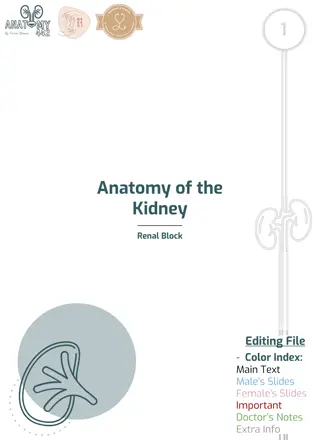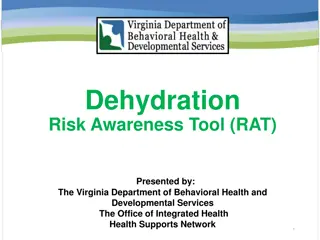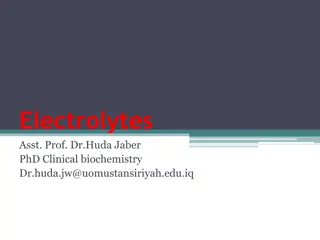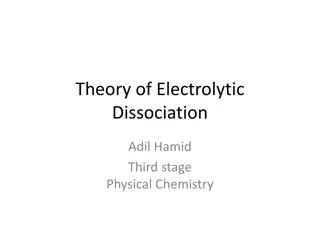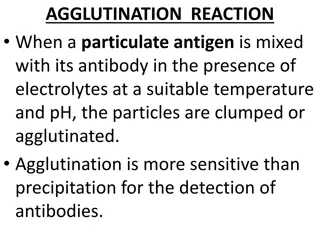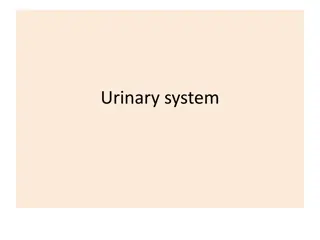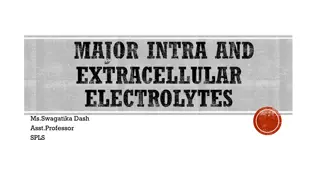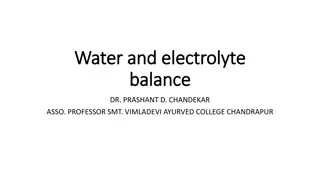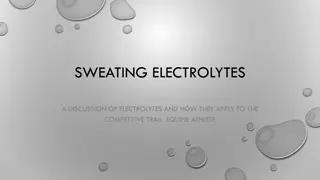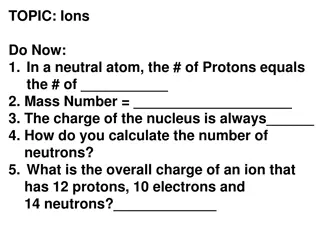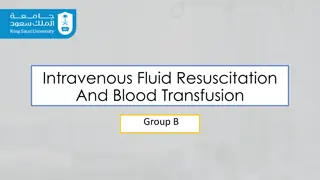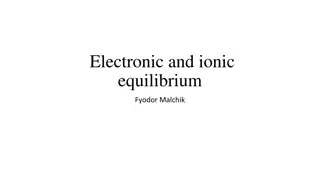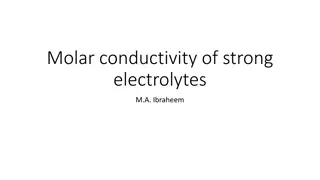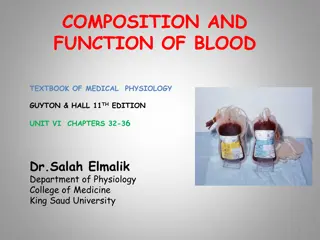Introduction to Physical Science
Explore the world of solutions in physical science through this detailed presentation by Robert Wagner. Learn about the basic properties of solutions, different types of solutions, the formation of solutions, electrolytes, and much more. Understand the concepts of solutes, solvents, homogeneity, and
0 views • 9 slides
Anatomy of the Kidney: Essential Features and Functions
The kidneys play a vital role in filtering waste products, regulating electrolyte balance, maintaining blood pH, producing hormones, and more. This article explores the anatomical features of the kidneys, including their position, extent, internal structure, vascular segments, and coverings. It also
0 views • 16 slides
Understanding Physiological Acid-Base Balance in Pharmaceutical Inorganic Chemistry
This lecture delves into the fundamental concepts of pharmaceutical inorganic chemistry, focusing on the mechanisms and uses of various pharmaceutical products that correct body disorders. Topics covered include acids and bases, intra and extracellular electrolytes, and the role of buffers in mainta
10 views • 14 slides
Understanding Voltammetry: Principles and Applications
In voltammetry, current is measured as a function of changing potential. The magnitude of current is directly proportional to the activity or concentration of the analyte. A voltammogram is plotted between current and potential, showing the characteristic half-wave potential. The process involves a
6 views • 76 slides
Dehydration Risk Awareness Tool (RAT) Overview
The Dehydration Risk Awareness Tool (RAT) presented by The Virginia Department of Behavioral Health and Developmental Services aims to educate DSPs, caregivers, and support coordinators about the importance of recognizing, preventing, and addressing dehydration. The tool covers topics such as signs
1 views • 20 slides
Culture Media
Culture media play a crucial role in isolating bacteria from clinical specimens. Water, electrolytes, peptone, agar, meat extract, yeast extract, and blood/serum are essential constituents used in culture media. These components provide nutrients, solidifying agents, and growth factors necessary for
1 views • 26 slides
Understanding Acid-Base Balance in Health and Disease
Many critical illnesses can disrupt acid-base balance, indicating underlying diseases or organ damage. Interpretation of disturbances requires analyzing arterial blood gases, plasma electrolytes, and compensatory mechanisms. Acid-base disorders are classified into respiratory acidosis, respiratory a
3 views • 26 slides
Understanding Nutrients, Vitamins, Minerals, and Water in Your Body
Explore the importance of nutrients, vitamins, minerals, and water in maintaining optimal health. Vitamins play crucial roles in bodily functions, while minerals act as catalysts. Water, a vital nutrient, regulates body functions and carries nutrients while removing waste. Learn about the different
0 views • 5 slides
Understanding Fluids and Electrolytes in Clinical Practice
This educational material by Dr. Emily Miller provides a comprehensive overview of major electrolytes, common fluid and electrolyte issues in the PICU, including causes and treatment of hyponatremia and hypernatremia. It also includes multiple-choice questions to test knowledge on the topic. The con
2 views • 31 slides
Understanding Electrolytes and Their Imbalances: Essential Information
Electrolytes are crucial chemicals that regulate various bodily functions, including nerve and muscle activity, hydration, and tissue repair. Imbalances in electrolyte levels can arise from various factors and conditions such as congestive heart failure, diabetes, dehydration, and intense physical a
0 views • 20 slides
Theories of Electrolytic Dissociation and Ionization in Physical Chemistry
The theories of electrolytic dissociation by Adil Hamid and Arrhenius explain how electrolytes dissociate into ions in solution, leading to electrical conductivity. This process involves the migration of cations and anions towards opposite electrodes, affecting the conductivity of the electrolyte. T
1 views • 51 slides
Understanding Agglutination Reactions in Immunology
Agglutination reaction is a key technique in immunology where particulate antigens and antibodies clump together in the presence of electrolytes. This reaction is highly sensitive and often used for antibody detection, bacterial identification, blood grouping, and cross-matching. The process involve
0 views • 20 slides
Understanding Intravenous Infusions and Injections in Healthcare
Intravenous infusions and injections play crucial roles in healthcare by delivering drugs and fluids directly into the body. Injections can be administered in various ways, including intravenous, intramuscular, and subcutaneous routes. Intravenous infusions provide fluids, electrolytes, and medicati
4 views • 20 slides
Overview of the Gastrointestinal System and Its Functions
The alimentary tract supplies the body with water, electrolytes, and nutrients through processes like movement of food, digestion, absorption, and circulation. The gastrointestinal tract, starting from the mouth to the anus, is aided by accessory organs for digestion. Functions include motility, sec
0 views • 29 slides
Understanding Parenteral Fluid Therapy and IV Solutions
This informative content explores the essentials of parental fluids therapy, including the indications, types of IV solutions (isotonic, hypotonic, hypertonic), and categories of intravenous solutions based on their purpose. It covers the significance of IV solutions containing dextrose or electroly
0 views • 37 slides
Understanding Interfacial Phenomena in Surfactant Solutions
Micelle formation is a key process in surfactant solutions, where the critical micelle concentration (CMC) is reached leading to the formation of micelles. The CMC decreases with longer hydrophobic chains and is influenced by the addition of electrolytes. Adsorption at solid interfaces and wetting p
1 views • 21 slides
Understanding Electrolytes in Chemical Solutions and Their Importance in Body Fluid Balance
Chemical compounds in solution can remain intact or dissociate into ions, affecting their electrical charge. Electrolytes like sodium chloride play a crucial role in body fluid balance and acid-base regulation. Electrolyte preparations are used to treat imbalances, with milliequivalents and molar co
1 views • 32 slides
Understanding Nonelectrolytes in Solutions
Physical properties of substances are classified into colligative, additive, and constitutive properties. Colligative properties depend on the number of particles in a solution and are similar for different nonelectrolytes. Additive properties are based on the total contribution of atoms, while cons
1 views • 14 slides
Understanding the Urinary System: Kidneys, Functions, and Structure
The urinary system, also known as the renal system, consists of the kidneys, ureters, bladder, and urethra. Each kidney contains nephrons, the functional units responsible for filtering waste and regulating blood volume, pressure, electrolytes, and pH balance. The kidneys have an extensive blood sup
0 views • 35 slides
Role of Major Physiological Anions in the Human Body
Physiological anions such as chlorides, sulphates, bicarbonate, phosphates, and electrolytes play essential roles in maintaining various functions within the body. Chloride ions help in osmotic balance, charge balance, and acid-base balance. Sulphates are important for detoxification mechanisms and
0 views • 11 slides
Understanding Major Intra and Extracellular Electrolytes in Body Fluids
Body fluids contain various electrolytes crucial for maintaining cell and tissue environments. Electrolyte balance is essential for overall health, and external electrolyte replacement therapy may be necessary in certain conditions. The body's fluid compartments - intracellular, interstitial, and pl
0 views • 10 slides
Strong vocational interest blank
Strong Vocational Interest Blank, introduced in 1927 by Edward Kellog Strong Jr., assesses individuals' career preferences based on their likes and dislikes across various dimensions. The Strong-Campbell Interest Inventory, a revised version, includes 124 occupational scales and 23 Basic Interest Sc
0 views • 12 slides
Understanding Electrolytes in Chemical Solutions
The content discusses the concept of electrolytes in chemical compounds, exploring how they can remain intact or dissociate into ions in solution. It explains the roles of electrolytes in body fluids, their movement in the presence of electrodes, and the use of electrolyte preparations in clinical p
3 views • 25 slides
Understanding Fluid Therapy in Animals: Basics and Indications
Explore the fundamental concepts of body fluids in animals, including their composition, types, routes of administration, and signs of fluid overload. Delve into the balance of intracellular and extracellular fluids, daily water intake and loss, and the role of electrolytes. Dr. Bipin Kumar provides
0 views • 33 slides
Comprehensive Treatment Guidelines for Acute Ischemic Stroke
In the management of acute ischemic stroke, the primary goals are to reduce secondary brain damage, maintain adequate perfusion, and prevent recurrent strokes by managing risk factors. Treatment includes maintaining tissue oxygenation, correcting volume status and electrolytes, managing blood glucos
0 views • 20 slides
Understanding Cyclic Voltammetry in Electrochemical Analysis
Cyclic voltammetry is a crucial electroanalytical technique for studying electrochemical behavior. It involves sweeping potential in a cyclic manner to measure current responses, aiding in understanding redox processes, electron transfer kinetics, and coupled reactions. The technique requires carefu
0 views • 10 slides
Understanding Water and Electrolyte Balance in the Human Body
The body's fluid compartments, including intracellular and extracellular fluids, play a crucial role in maintaining water and electrolyte balance. This balance is regulated by movements of water and electrolytes between compartments, influenced by factors like hydrostatic and osmotic pressures. Main
2 views • 18 slides
Start Strong Fall 2022 Administration District Test Coordinator Training
Delve into the comprehensive training agenda for the Start Strong Fall 2022 Administration, focusing on key aspects such as testing requirements, technology setup, reporting groups, accessibility features, and more. Understand the differences between Start Strong and NJSLA assessments, key dates, an
0 views • 58 slides
Understanding Interfacial Phenomena and Micelle Formation
Interfacial phenomena play a crucial role in the formation of micelles in surfactant solutions, leading to a decrease in surface tension. The critical micelle concentration (CMC) marks the point where micelles first form in the solution. Factors like chain length and electrolytes impact CMC and mice
0 views • 20 slides
Understanding Electrolytes and Their Importance for Trail Equine Athletes
Explore the crucial role of electrolytes for competitive trail equine athletes, including their functions, absorption in the body, sources of loss, and homemade electrolyte formulations. Learn how electrolytes such as sodium, potassium, and chloride are essential for muscle function, intestinal moti
0 views • 22 slides
Understanding Ions and Their Importance in Your Body
Neutral atoms have the same number of protons and electrons, with the charge of the nucleus always positive. The mass number is the sum of protons and neutrons. The number of neutrons can be calculated by subtracting the atomic number from the mass number. Ions are atoms with a positive or negative
0 views • 15 slides
Understanding Intravenous Fluid Resuscitation and Blood Transfusion in Clinical Practice
Intravenous fluid resuscitation and blood transfusion are crucial components of patient care, involving the direct administration of fluids and electrolytes to maintain proper fluid balance. When calculating the volume of fluid to be replaced, various factors must be considered, including maintenanc
0 views • 15 slides
Understanding Electrolytes and Ionic Equilibrium in Chemistry
Electrolytes play a crucial role in conducting electricity through ionization in aqueous solutions, with examples of strong and weak electrolytes explained. The concept of ionic equilibrium, degree of dissociation, and distinction between non-electrolytes are also covered in this comprehensive overv
0 views • 21 slides
Understanding Blood Composition and Functions in Medical Physiology
Blood, a vital fluid tissue in the cardiovascular system, plays crucial roles in transportation, regulation, and protection. Comprised of cellular and non-cellular components suspended in plasma, it facilitates the transport of gases, nutrients, hormones, and waste products, regulates temperature, p
0 views • 22 slides
Understanding Galvanic Cells in Materials Engineering
Exploring galvanic cells in materials engineering, we delve into examples involving zinc, nickel, copper, and platinum electrodes immersed in various electrolytes. By analyzing oxidation and reduction reactions, we determine electrode roles, corrosion tendencies, and cell potentials to understand th
0 views • 28 slides
Understanding Summer Fatigue and its Symptoms
Hot summer days may bring enjoyable outdoor activities but can also lead to symptoms of fatigue, insomnia, dehydration, and heat exhaustion. Environmental temperature fluctuations and lack of proper electrolytes may contribute to tiredness and exhaustion. Recognizing the signs and symptoms can help
0 views • 19 slides
Differential Diagnosis of Infant with Sudden Onset Weakness and Neurological Symptoms
A 2-month-old infant presented with sudden onset weakness in all four limbs following an upper respiratory tract infection. Clinical findings include froglike posture, diminished tone in all limbs, absent reflexes, and cranial nerve involvement. Possibilities include brainstem encephalitis, myelitis
0 views • 29 slides
Understanding Molar Conductivity of Strong Electrolytes
Strong electrolytes are materials highly dissociated in water, leading to conducting solutions with high molar conductivity. This article delves into the concept, calculation methods, and experimental procedures for determining the molar conductivity of strong electrolytes using examples of NaCl, KC
0 views • 5 slides
Composition and Function of Blood in Medical Physiology Textbook
Blood, a vital fluid tissue in the cardiovascular system, plays essential roles in transportation, regulation, and protection within the body. This includes carrying gases, nutrients, hormones, and waste products, regulating temperature, pH, electrolytes, and blood pressure, as well as providing def
0 views • 24 slides
Strong Support, Strong Futures NDIS Provider Brisbane Righteous Community Care
Strong Support, Strong Futures NDIS Provider Brisbane Righteous Community Care
0 views • 6 slides

